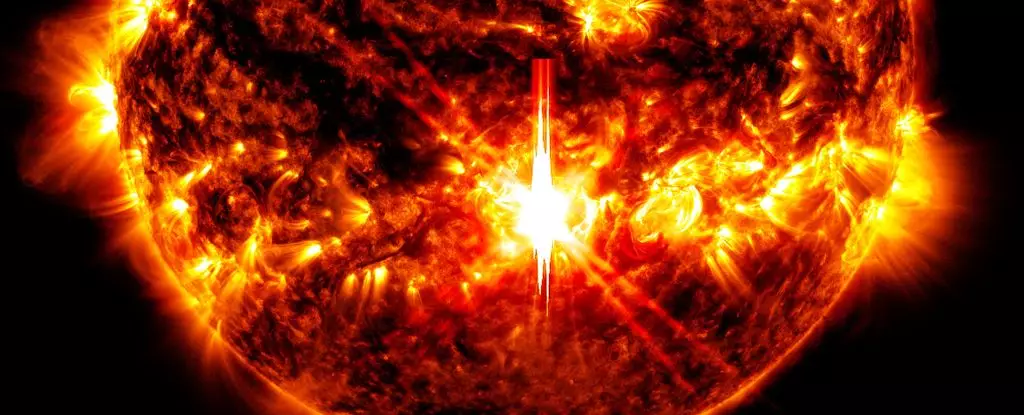

On October 3, 2024, the Sun unleashed a solar flare of unprecedented intensity, measuring a staggering X9.0 on the Richter scale of solar phenomena. This event marks the most powerful flare observed in over seven years, and it brings with it a tidal wave of implications for both science and everyday life on Earth. Coinciding with this burst of energy was a halo coronal mass ejection (CME), aimed directly at our planet, which heightens our urgency to understand these cosmic displays.
The recent solar activity can be attributed to the Sun’s ongoing 11-year cycle, during which its magnetic and physical properties pass through periods of peak activity. As scientists have noted, we’ve been experiencing a noticeable uptick in the number of solar flares since early 2022, with many being less severe but nonetheless impactful. The current spike in X-class flares—classified as the most potent category—indicates that we are in the midst of a period of heightened solar phenomena. The X9.0 flare from October 3 is not only a testament to this cycle but also ranks among the top 20 most powerful flares recorded thus far.
At the heart of this solar explosion lies sunspot region AR 3842, characterized by a distressed magnetic field configuration named ‘Beta-Gamma-Delta’. This classification signifies a complex interaction of magnetic fields where opposite polarities can unexpectedly intertwine. Such tangling can lead to mass energy releases, allowing for solar flares to occur. The nature of these sunspots adds depth to our understanding of solar activity since they act as the hotspots of energy interactions: areas where the magnetic field is temporarily stronger and inherently unstable.
Before the monumental X9.0 flare, AR 3842 had already demonstrated its high-energy capabilities by producing an X7.1 flare just two days earlier. As these flares exhibit an increasingly intense barrage of energy, they challenge our perceptions of solar activity and its potential consequences.
The repercussions of such a formidable flare extend beyond mere observation; they invite scrutiny regarding terrestrial impacts. On our planet, while we are generally shielded from the harmful effects of X- and gamma radiation due to Earth’s atmosphere, the immediate interference during such solar events can disrupt high-frequency radio communications. This disruption can pose challenges for air travel and maritime navigation.
However, the more daunting concern is the coronal mass ejection (CME). A CME consists of billions of tons of solar particles and tangled magnetic fields that can travel through the solar system and interact with Earth’s magnetosphere. When a CME strikes, it can instigate geomagnetic storms, which present several tangible effects: fluctuations in power grids, increased drag on satellites, and the potential for GPS inaccuracy.
Although a single CME typically does not create overwhelming problems, its impact can manifest in heightened auroras, particularly in latitudes as far south as 50 degrees. The artistry of auroras, produced as solar particles engage with Earth’s magnetic field, translates into a breathtaking light display. These natural phenomena are triggered by the complex physics of energy transfer and result in a colorful spectacle that paints the night skies.
Following the October 3 flare, the National Oceanic and Atmospheric Administration (NOAA) has forecasted an extended period of peak aurora conditions, suggesting that observers in suitable latitudes may well be treated to extraordinary displays. It is worth noting that the phenomenon of a ‘cannibal CME’—where one CME overtakes another—exacerbates anticipated effects, although the timings from recent flares indicate this scenario is less likely to play out in this case.
The recent surge in solar activity reignites a keen interest in monitoring and observing solar phenomena. Scientists and skywatchers alike have ample reasons to remain watchful in the days ahead, as conditions are ripe for spectacular displays of nature’s fury, offering a unique opportunity to witness the awe-inspiring interplay between solar dynamics and Earth.
As we navigate this lively solar phase, it’s essential for the scientific community to continue gathering data and refining our understanding of these cosmic interactions. The delicate dance of the Sun’s energy, its impacts on Earth, and the beauty borne of chaos continues to deepen our appreciation for this stellar neighbor.
In the realm of software development, the ability to swiftly and accurately address bugs is…
The realm of quantum computing and communication is not just an abstract dream anymore; it…
In a remarkable leap for the field of material science, a collaborative research initiative has…
Throughout Earth's vast history, our planet has endured five major mass extinction events that reshaped…
Rainfall is a vital element of our planet’s hydrological cycle, yet many aspects of its…
On a night when the universe aligns, a mesmerizing phenomenon awaits: the appearance of the…
This website uses cookies.